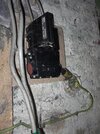If you have the skills to do it safely, as mentioned before you can do :
IR tests. If there's anything on the low side you can investigate that and deal with it.
Continuity tests. r1+r2 on everything, and of course, check all the rings are actually rings.
Plus one not mentioned - check for borrowed neutrals on landing lights (i.e. a light fed from one circuit, but using the neutral from another - typically upstairs and downstairs). This is something that (if split across different RCDs or RCBOs) will make RCDs trip consistently all the time if not fixed.
As mentioned, if you can find and fix any of these issues, then it'll be cheaper than paying someone else to do it. A spark won't use your results, but if should give you confidence that there won't be major problems once work is under way to replace the CU.
IR tests. If there's anything on the low side you can investigate that and deal with it.
Continuity tests. r1+r2 on everything, and of course, check all the rings are actually rings.
Plus one not mentioned - check for borrowed neutrals on landing lights (i.e. a light fed from one circuit, but using the neutral from another - typically upstairs and downstairs). This is something that (if split across different RCDs or RCBOs) will make RCDs trip consistently all the time if not fixed.
As mentioned, if you can find and fix any of these issues, then it'll be cheaper than paying someone else to do it. A spark won't use your results, but if should give you confidence that there won't be major problems once work is under way to replace the CU.


